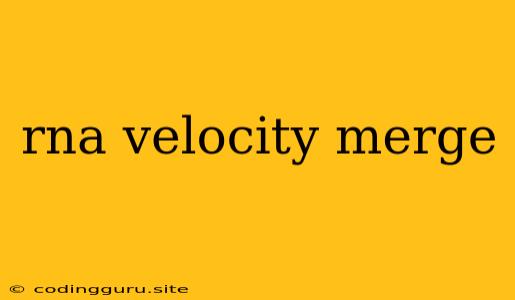Understanding RNA Velocity and Its Role in Merging Single-Cell RNA Sequencing Data
Single-cell RNA sequencing (scRNA-seq) has revolutionized our understanding of cellular heterogeneity and dynamic processes. However, scRNA-seq data often captures a snapshot of cells at a specific moment, lacking information about their developmental trajectories. RNA velocity emerges as a powerful tool to address this limitation, offering insights into the direction and rate of gene expression changes, effectively predicting the future state of cells.
What is RNA Velocity?
RNA velocity is a computational method that analyzes the relationship between spliced and unspliced mRNA transcripts in scRNA-seq data to infer the direction and rate of gene expression changes. It is based on the premise that unspliced mRNA represents nascent transcripts that will eventually be spliced into mature mRNA. By comparing the abundance of spliced and unspliced transcripts for each gene, RNA velocity can determine whether a gene is being transcribed at an increasing or decreasing rate.
Why Merge RNA Velocity Data?
Merging RNA velocity data from multiple datasets can provide a more comprehensive and informative view of cellular dynamics. For instance, merging data from different time points or treatments can reveal how cells respond to changes in their environment. Moreover, integrating data from different studies can enhance statistical power and identify subtle trends that might be missed in individual datasets.
How to Merge RNA Velocity Data?
Merging RNA velocity data involves integrating the information from multiple datasets while preserving the temporal information encoded in the velocity vectors. This can be achieved through various approaches:
- Batch Correction: Correcting for batch effects, such as technical variations between datasets, is crucial for accurate integration. Methods like Harmony or ComBat can be used to remove batch-specific biases.
- Integration of Spliced and Unspliced Counts: Combining the spliced and unspliced counts from multiple datasets before performing RNA velocity analysis can provide a more robust estimate of velocity vectors.
- Alignment of Velocity Vectors: Aligning the RNA velocity vectors from different datasets to a common reference frame is essential for comparing and interpreting the results. This can be achieved using tools like Velocyto.
Tips for Merging RNA Velocity Data:
- Data Pre-processing: Ensure that the datasets are properly pre-processed, including normalization, quality control, and filtering.
- Harmonization: Correct for batch effects to avoid spurious differences between datasets.
- Visualization: Utilize visualization tools to assess the integration process and identify potential issues.
- Validation: Validate the merged RNA velocity results by comparing them to known biological processes or independent experimental data.
Example Scenario:
Imagine you are studying the development of blood cells. You have scRNA-seq data from three time points: day 0, day 3, and day 7. Using RNA velocity, you can infer the trajectories of individual cells through these developmental stages. By merging the RNA velocity data from all three time points, you can obtain a comprehensive map of blood cell development and identify potential regulatory genes involved in differentiation.
Conclusion:
RNA velocity is a powerful tool for studying cellular dynamics, and merging RNA velocity data from multiple datasets can provide a more complete and insightful picture. By carefully considering the methods for integration and validation, researchers can leverage the power of RNA velocity to gain a deeper understanding of cellular processes and developmental trajectories.
